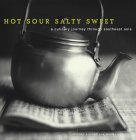|
That Which Separates Unites
Hot Sour Salty Sweet: A Culinary Journey Through Southeast Asia
After watching a rookie prospect bobble three or four consecutive grounders to third, Durocher (by this time a manager) steps onto the field, sends the rookie to the dugout, and says, "Let me show you how third base is played, kid." Next ball bounces fair down the line to Durocher, skids off his shins, caroms into the outfield. Durocher turns to the kid and screams, "Now look what you've done. You got third base so screwed up nobody can play it!" As much might be said of some fusioneering chefs and trendy home cooks who so lemon-grass and chile-fy their preparations as to lead one diner to wonder if what is sometimes set before him in the name of mainland Southeast Asia cookery is to be eaten or rubbed on a congested chest. Despair not. There is yet hope for us North American and European rookies. Comes now voices of patience and skill in the persons Jeffrey Alford and Naomi Duguid, the Canadian couple who gave us "Flatbreads and Flavors" and "The Seductions of Rice." Their latest opus, "Hot Sour Salty Sweet: A Culinary Journey Through Southeast Asia," sets things right by drawing a new culinary map showing us that, insofar as peninsular Southeast Asia, is concerned, that which separates unites. They tell us that the Mekong, which rises in Tibet and falls in Vietnam, is more than the world's tenth-longest river. Its caressing banks shape an aorta that both borders and nourishes five Southeast Asian nations -- South China, Burma, Laos, Thailand, and Viet Nam (but, strangely, not Tibet). Just as their racial and national analogues on the Mediterranean rim share a gastronomy that is at once homogeneous and individual, the riparian peoples of these Asian cultures orchestrate four fundamental tastes -- the eponymous hot, salty, sweet, and sour -- to produce five highly diverse yet related national cuisines. But things are not quite so simple in practice as in theory. The people of the region, like their foods, are a complicated mix of the indigenous, settlers, and conquerors. Take the Thai, who are not one people but several, each with its own cuisine within a cuisine. Northern Thailand enjoys cool winters in which the palms that loom large in the sweet coconut-milk richness of Bangkok food do not thrive, hardly any fish is eaten, but beef, water buffalo, and pork are staples. Predominant flavors are hot and sour, and the rice of choice is sticky. Meanwhile, in the country's northeast quadrant (Issan), where drought is endemic, ingredients that can be gathered rather than cropped are important -- bamboo shoots, mushrooms, roots, and leaves. Fish from the Mekong is also relied upon and is eaten fresh and dried, salted and fermented in the form of sauces and pastes. Here the cookery is direct, forceful, and chile-hot, as in chicken rubbed with a paste of coriander root and black pepper and then roasted in banana leaf. Herein, among a jillion cultural traits and habits that define and distinguish the subtleties of one cuisine from another, we learn that the Yunnanese prefer salt to soy sauce, that aromatic jasmine rice is the favorite in Cambodian home-style cooking, and that snake is a favored viand in Vietnam, where the genius for combining fresh and cooked ingredients is evident in rice paper rollups. The authors present about 175 recipes for salsas, soups, grilled meat salads, and exotic desserts. Chapters are organized by food types, and dishes from different cuisines are presented side by side. For instance, a hearty Lao chicken soup is positioned adjacent to Vietnamese ginger-chicken soup; a Thai vegetable stir-fry follows stir-fried potatoes from Yunnan. The book invites a flexible approach to cooking, encouraging readers to serve dishes from different places in the same meal. Also included are useful glossaries of flavorings and of ingredients. From the point of view of production values, this is a book whose oversize format (11½ x 9¾) and undersize typography work against the interests of serious cooks. The richness of photographic illustrations (on location by the authors, studio shots by Richard Jung) is interesting, but for the most part decorative -- ephemeral either to the culture being discussed or the food under examination. And therein lies a clue to the book's single but major failing: it doesn't know what it wants to be when it grows up. Is it an examination of Mainland Southeast Asian food or the life that surrounds it? If the latter, it is as woefully short on insight as it is long on observation; and if the former, surely more recipes could have been found to justify nearly 350 beautifully-printed pages. It is of course up to the reader to make the ultimate determination but it seems safe to think that, in the end, this will be seen more as a coffee table book than a cookery. Pray, do not think this an altogether bad thing. By winning popularity and informing the food consciousness of many, it will encourage a hardy group of future writers and readers to delve deeper into the culinary wonders of a river system largely unknown to the West but probably already familiar to our brothers and sisters in food down under. March 2001
|
 Now that spring training has opened, a possibly apocryphal story about Hall of Famer Leo Durocher once again makes press box rounds.
Now that spring training has opened, a possibly apocryphal story about Hall of Famer Leo Durocher once again makes press box rounds.